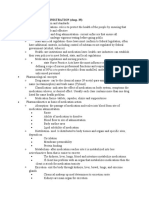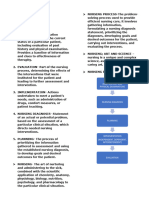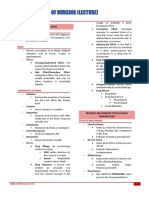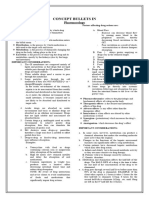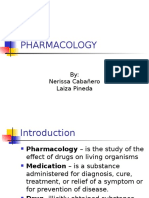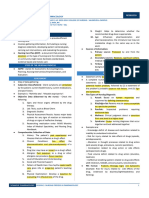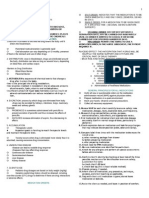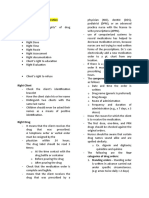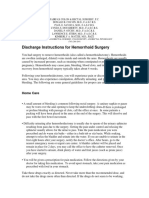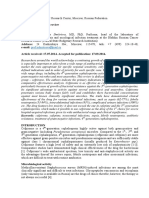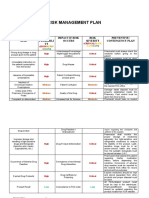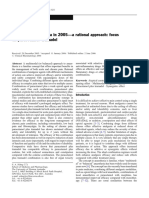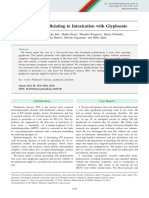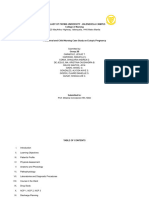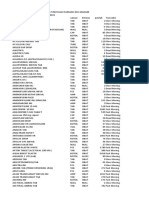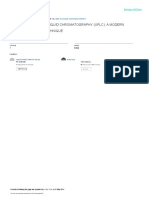PHARMACODYNAMICS Rate of elimination is the lowest plasma
concentration of drug and measures the w/c the
Mechanism by which drugs produce change in the drug is eliminated
body
WAYS OF DRUGS ACTS IN THE BODY
DESIRED EFFECT – intended action of drugs
PROPHYLAXIS – Prevents/lessen severity of
SIDE EFFECTS disease
ADVERSE EFFECTS PALLIATIVE/SYMPTOMATIC – Relieve distressing
TOXIC EFFECT symptoms of disease
IDIOSYNCRATIC EFFECT CURATIVE/SPECIFIC – ELIMINATE THE DISEASE
SUPPORTIVE – Sustain Pt until measures can be
SIDE EFFECT
instituted that will cure or alleviate the condition
consequence reaction (desirable/undesirable) SUBSTITUTE/REPLACEMENT – Replace substance
should not outweigh benefits of drugs normally found in the body
Example: Teratogenic (Damaging the fetus), SUPPLEMENTARY – Added as a supplement or
mutagenic, carcinogenic something that supplies a deficiency
CHEMOTHERAPEUTIC – Use of certain
ADVERSE EFFECT drugs/chemicals to manage cancer
Harmful unintended reaction RESTORATIVE – Help return the body to its normal
state
TOXIC EFFECT DIAGNOSTIC – radiopaque dyes. Example. MRI
THERAPEUTIC USE – Desired effects (Ex. Antacids,
The degree which something is poisonous
antibiotics)
IDIOSYNCRATIC EFFECT
PRESCRIPTION DRUGS – Requires an order from
UNPREDICTABLE RESPONSE physician/dentist
Effects that cannot be explained
NON-PRESCRIPTION DRUGS - OTC drugs
HALF LINE
FACTORS INFLUENCING DRUG EFFECTS
Time it takes to half the drug concentration to be
WEIGHT
eliminated
AGE
LOADING DOSE GENDER
PHYSIOLOGICAL FACTORS
Large initial dose given when immediate drug PATHOLOGICAL FACTORS GENETIC FACTORS
response is desired; double the dose IMMUNOLOGIC FACTORS
AGONIST PSYCHOLOGICAL FACTORS
ENVIRONMENTAL FACTORS
Drugs that produce a response
COMMON LAW
ANTAGONIST
STANDING ORDER (ACTIVE ORDER)
Drugs that block a response
clearly written (drug name, route, frequency
THERAPEUTIC INDEX
specific circumstances for PRN medications
Estimates the margin of safety of a drug do not accept or carry out unclear orders
Low TI = narrow margin of safety
EMERGENCIES/VERBAL ORDERS
High TI = wide margin of safety and less danger of
producing toxic effects emergency situation only
telephone orders
PEAK DRUG LEVEL
NURSING PROCESS
Rate of absorption is the highest plasma
concentration of drug at a specific time Essential care of practice for nurses
Support nurse in prioritizing the safe, timely
THROUGH DRUG LEVEL
delivery of drug administration
ADPIE
�ASSESSMENT EXAMPLE: The Pt will independently administer
the prescribed dose of 4 units of regular insulin by
Starts with therapeutic relationship
the end of the fourth session of instruction
SUBJECTIVE DATA
INTERVENTION
Pt verbalizes the data
Client education and teaching is the key nursing
Use of open-ended questions
responsibility during this phase
Symptoms
In some practice setting, administration of drug
and assessment of drug are also important
o Current health history
responsibility
o Swallowing problem
o Knowledge of the Pt about medication and side EVALUATION
effects
Determining whether goals and teaching
o Allergies, tobacco, and alcohol usage
objectives are being met. NOTE: if objective is not
o Financial barriers met, revision is necessary, otherwise if met,
o Caregivers and support systems documentation is warranted
OBJECTIVE DATA
FDAR = FOCUS, DATA, ACTION, RESPONSE
The nurse directly observes about the Pt’s health
DRUG SAFETY
status
Signs 1. Check the order
a. Client’s name
o Physical health assessment b. Date and time order was written
o Lab results c. Name of the medication
o Data from physician’s notes d. Dosage
o VS e. Route of delivery
o Body language f. Signature of prescriber
2. Always verify the 6 rights
DIAGNOSIS a. Right Pt
Based n the analysis of the data b. Right drug
More than one applicable nursing diagnosis may c. Right dose
be generated d. Right time
May be actual or potential; Ex. Non-compliant e. Right route
Individualized for each patient f. Right documentation
Based from medical condition and the drug he/she RIGHT Pt
is receiving
Verify Pt with 2 forms of verification
o Knowledge deficit about drug action, Compare Pt stated name and birth date with Pt’s
administration and side effects related to ID band and MAR (medication administration
language difficulties record
o Potential for injury related side effects of drugs Scan Pt’s barcode on their ID band
such as dizziness and drowsiness, 2°CVA Verify Pt’s name with family member if present
o Alteration in thought processes r/t forgetfulness, Check for “name alert” sticker when have the
same name
affecting whether the client takes medication as
prescribed. RIGHT DRUG
PLANNING Scan medication
Check if the order is prescribed by the licenced
Setting goals, expected outcomes and
healthcare provider
interventions
Read drug label 3x
Realistic, measurable, reasonable
- When meds are taken out of the storage
Acceptance to Pt and nurse
- When meds are being poured/administered
Dependent on Pt’s ability
- When meds are being put away at bedside
Shared with other healthcare provider
Be familiar with Pt’s health record, allergies, lab
results, vital signs
� Know why Pt is receiving meds and correct for Pt’s - Most common drug forms
diagnosis Liquids
Check dose calculations - Elixirs, emulsions, suspensions
Note the beginning and ending date of meds Transdermal
- Medication restored patched on skin
RIGHT DOSE
Topical
Verify dosage calculations - Cream, ointment
Verify if drug is safe for Pt Instillations
If dose is dependent upon Pt’s weight - Drops, sprays
Validate dose of certain drugs like insulin and
heparin with 2 RNs ROUTES OF ADMINISTRATION
RIGHT TIME ENTERAL
Use health care agency policy Oral
Use of military time reduces errors (24 hr format) - Most commonly used easiest, safer, preferred
Drugs affected by food are given 1 hr ac or 2 hr pc by clients
Give food with drugs that irritates the stomach - Slower onset of action, more prolonged effect
Check scheduled procedures - Do not use when vomiting
Administer antibiotics at even intervals Sublingual
Hold antihypertensives prior to dialysis if ordered - Faster, avoid gastric irritation, and first-pass
effect
RIGHT ROUTE
PARENTERAL
Necessary for adequate absorption
Assess the ability to swallow oral meds Administered via injections
Do not crush or mix meds w/o ID
validation/consultation - 0.5cc, 5° - 15° angle
Offer Pt water but not juice - No aspiration required, don’t massage (wheal)
Use aseptic technique - Slowest in absorption among parenteral route
SC
RIGHT DOCUMENTATION - 45° - 90° angle, slow absorption, no aspiration
required
Record administration immediately
- Slow, sustained rate of absorption. Example:
Record drug name, dose, route, time, date, RN’s
insulin, heparin
signature or initials according to agency policy
- Bony prominence
Document response to drug especially analgesics,
IM
sedative, and antiemetics (for vomiting)
- 0.5cc
- 2cc, Deltoid
3. Question drug orders that are unclear, appear to
- 3cc ventrogluteal
contain errors, or have potential to harm
- Vastus lateralis
4. Prepare drugs for one Pt at a time. Never leave
Z-TRACK
meds on cart or tray unattended
- Pull skin to one side, hold, insert needle
5. Check history for allergies and potential drug
- Hold skin to side, inject needle and medication
interactions before administering a newly ordered
- Wait for 10 secs, withdraw needle, release
drug
skin
6. Inform prescribing physician of any observed
IV
adverse effect; if cannot be located, inform
- Needle or tub, very fast effect, 100%
nursing supervisor
bioavailability
7. Take the following actions if an error occurs:
- Standard IV line (replaced after 4 days)
a. Notify nursing supervisor, prescribing
- Central venous catheter (replaced after a
physician, pharmacist
month)
b. Assess client’s condition and provide
- Common site of IV: Radial vein, median
necessary care
cubital, cephalic vein, basilic vein
c. Make an incidence report
DRUG FORMS
Tablets and capsules











